Many scholars can also be seen
VerifiedAdded on 2022/09/06
|9
|2385
|12
AI Summary
Contribute Materials
Your contribution can guide someone’s learning journey. Share your
documents today.
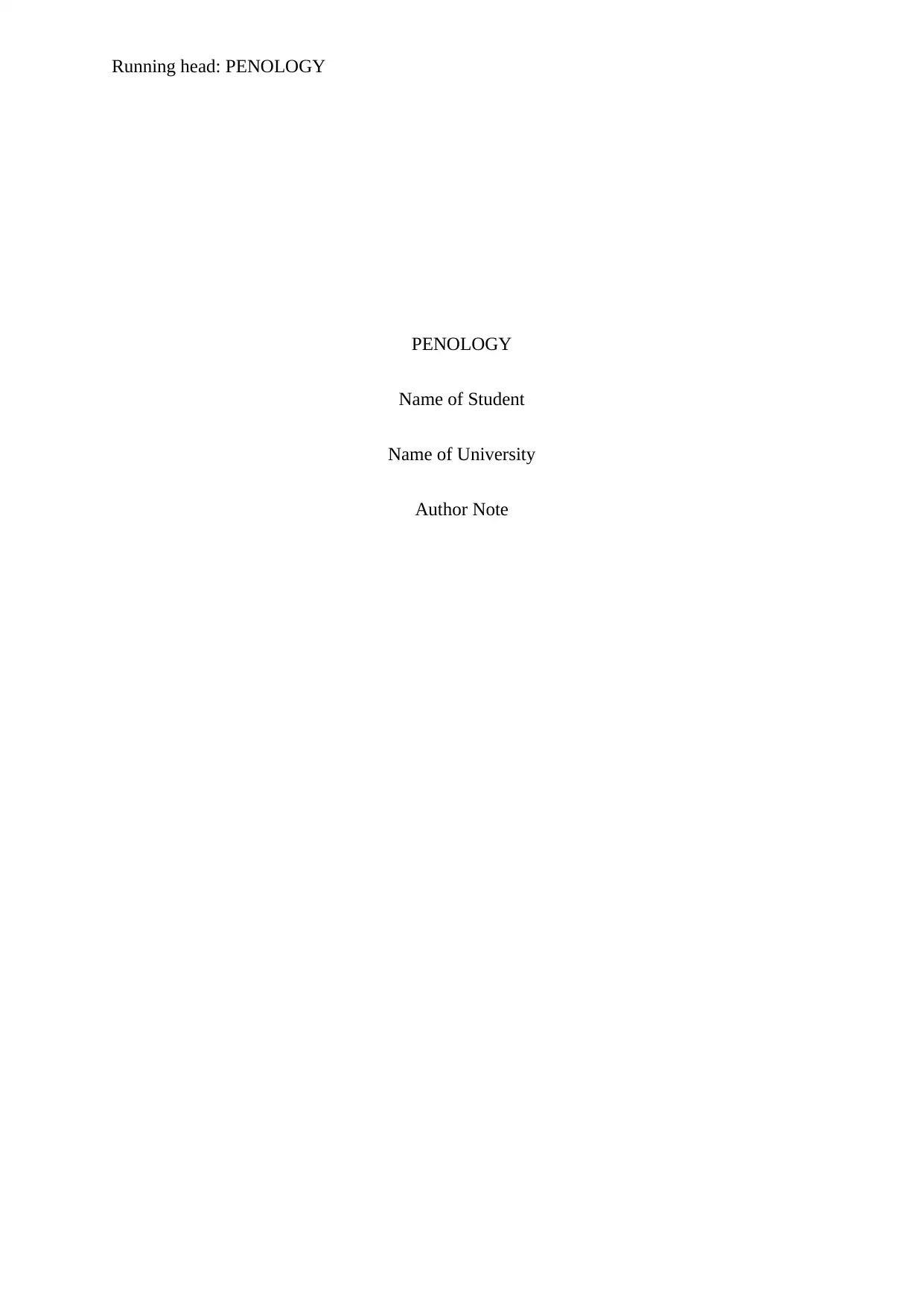
Running head: PENOLOGY
PENOLOGY
Name of Student
Name of University
Author Note
PENOLOGY
Name of Student
Name of University
Author Note
Secure Best Marks with AI Grader
Need help grading? Try our AI Grader for instant feedback on your assignments.
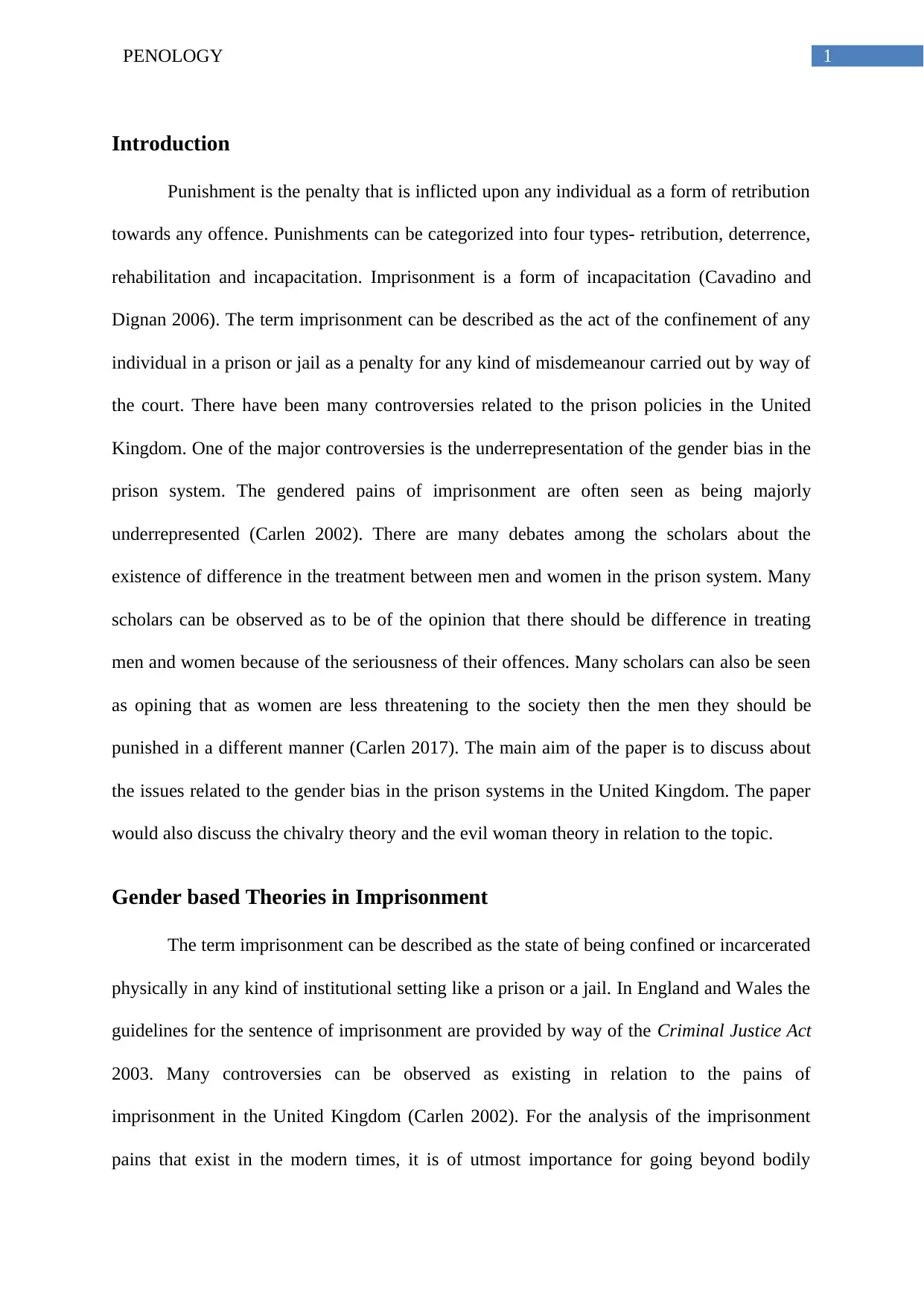
1PENOLOGY
Introduction
Punishment is the penalty that is inflicted upon any individual as a form of retribution
towards any offence. Punishments can be categorized into four types- retribution, deterrence,
rehabilitation and incapacitation. Imprisonment is a form of incapacitation (Cavadino and
Dignan 2006). The term imprisonment can be described as the act of the confinement of any
individual in a prison or jail as a penalty for any kind of misdemeanour carried out by way of
the court. There have been many controversies related to the prison policies in the United
Kingdom. One of the major controversies is the underrepresentation of the gender bias in the
prison system. The gendered pains of imprisonment are often seen as being majorly
underrepresented (Carlen 2002). There are many debates among the scholars about the
existence of difference in the treatment between men and women in the prison system. Many
scholars can be observed as to be of the opinion that there should be difference in treating
men and women because of the seriousness of their offences. Many scholars can also be seen
as opining that as women are less threatening to the society then the men they should be
punished in a different manner (Carlen 2017). The main aim of the paper is to discuss about
the issues related to the gender bias in the prison systems in the United Kingdom. The paper
would also discuss the chivalry theory and the evil woman theory in relation to the topic.
Gender based Theories in Imprisonment
The term imprisonment can be described as the state of being confined or incarcerated
physically in any kind of institutional setting like a prison or a jail. In England and Wales the
guidelines for the sentence of imprisonment are provided by way of the Criminal Justice Act
2003. Many controversies can be observed as existing in relation to the pains of
imprisonment in the United Kingdom (Carlen 2002). For the analysis of the imprisonment
pains that exist in the modern times, it is of utmost importance for going beyond bodily
Introduction
Punishment is the penalty that is inflicted upon any individual as a form of retribution
towards any offence. Punishments can be categorized into four types- retribution, deterrence,
rehabilitation and incapacitation. Imprisonment is a form of incapacitation (Cavadino and
Dignan 2006). The term imprisonment can be described as the act of the confinement of any
individual in a prison or jail as a penalty for any kind of misdemeanour carried out by way of
the court. There have been many controversies related to the prison policies in the United
Kingdom. One of the major controversies is the underrepresentation of the gender bias in the
prison system. The gendered pains of imprisonment are often seen as being majorly
underrepresented (Carlen 2002). There are many debates among the scholars about the
existence of difference in the treatment between men and women in the prison system. Many
scholars can be observed as to be of the opinion that there should be difference in treating
men and women because of the seriousness of their offences. Many scholars can also be seen
as opining that as women are less threatening to the society then the men they should be
punished in a different manner (Carlen 2017). The main aim of the paper is to discuss about
the issues related to the gender bias in the prison systems in the United Kingdom. The paper
would also discuss the chivalry theory and the evil woman theory in relation to the topic.
Gender based Theories in Imprisonment
The term imprisonment can be described as the state of being confined or incarcerated
physically in any kind of institutional setting like a prison or a jail. In England and Wales the
guidelines for the sentence of imprisonment are provided by way of the Criminal Justice Act
2003. Many controversies can be observed as existing in relation to the pains of
imprisonment in the United Kingdom (Carlen 2002). For the analysis of the imprisonment
pains that exist in the modern times, it is of utmost importance for going beyond bodily
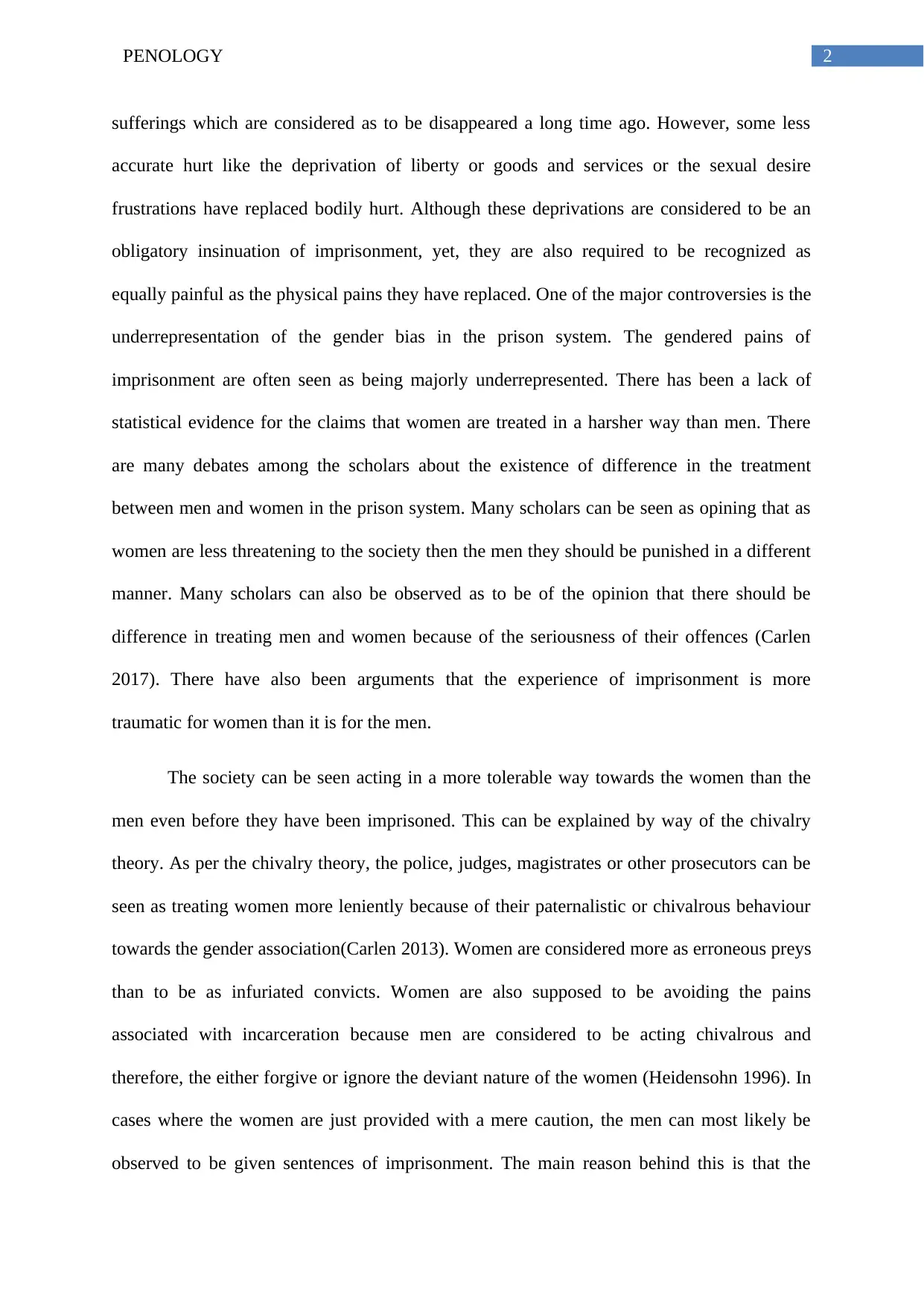
2PENOLOGY
sufferings which are considered as to be disappeared a long time ago. However, some less
accurate hurt like the deprivation of liberty or goods and services or the sexual desire
frustrations have replaced bodily hurt. Although these deprivations are considered to be an
obligatory insinuation of imprisonment, yet, they are also required to be recognized as
equally painful as the physical pains they have replaced. One of the major controversies is the
underrepresentation of the gender bias in the prison system. The gendered pains of
imprisonment are often seen as being majorly underrepresented. There has been a lack of
statistical evidence for the claims that women are treated in a harsher way than men. There
are many debates among the scholars about the existence of difference in the treatment
between men and women in the prison system. Many scholars can be seen as opining that as
women are less threatening to the society then the men they should be punished in a different
manner. Many scholars can also be observed as to be of the opinion that there should be
difference in treating men and women because of the seriousness of their offences (Carlen
2017). There have also been arguments that the experience of imprisonment is more
traumatic for women than it is for the men.
The society can be seen acting in a more tolerable way towards the women than the
men even before they have been imprisoned. This can be explained by way of the chivalry
theory. As per the chivalry theory, the police, judges, magistrates or other prosecutors can be
seen as treating women more leniently because of their paternalistic or chivalrous behaviour
towards the gender association(Carlen 2013). Women are considered more as erroneous preys
than to be as infuriated convicts. Women are also supposed to be avoiding the pains
associated with incarceration because men are considered to be acting chivalrous and
therefore, the either forgive or ignore the deviant nature of the women (Heidensohn 1996). In
cases where the women are just provided with a mere caution, the men can most likely be
observed to be given sentences of imprisonment. The main reason behind this is that the
sufferings which are considered as to be disappeared a long time ago. However, some less
accurate hurt like the deprivation of liberty or goods and services or the sexual desire
frustrations have replaced bodily hurt. Although these deprivations are considered to be an
obligatory insinuation of imprisonment, yet, they are also required to be recognized as
equally painful as the physical pains they have replaced. One of the major controversies is the
underrepresentation of the gender bias in the prison system. The gendered pains of
imprisonment are often seen as being majorly underrepresented. There has been a lack of
statistical evidence for the claims that women are treated in a harsher way than men. There
are many debates among the scholars about the existence of difference in the treatment
between men and women in the prison system. Many scholars can be seen as opining that as
women are less threatening to the society then the men they should be punished in a different
manner. Many scholars can also be observed as to be of the opinion that there should be
difference in treating men and women because of the seriousness of their offences (Carlen
2017). There have also been arguments that the experience of imprisonment is more
traumatic for women than it is for the men.
The society can be seen acting in a more tolerable way towards the women than the
men even before they have been imprisoned. This can be explained by way of the chivalry
theory. As per the chivalry theory, the police, judges, magistrates or other prosecutors can be
seen as treating women more leniently because of their paternalistic or chivalrous behaviour
towards the gender association(Carlen 2013). Women are considered more as erroneous preys
than to be as infuriated convicts. Women are also supposed to be avoiding the pains
associated with incarceration because men are considered to be acting chivalrous and
therefore, the either forgive or ignore the deviant nature of the women (Heidensohn 1996). In
cases where the women are just provided with a mere caution, the men can most likely be
observed to be given sentences of imprisonment. The main reason behind this is that the
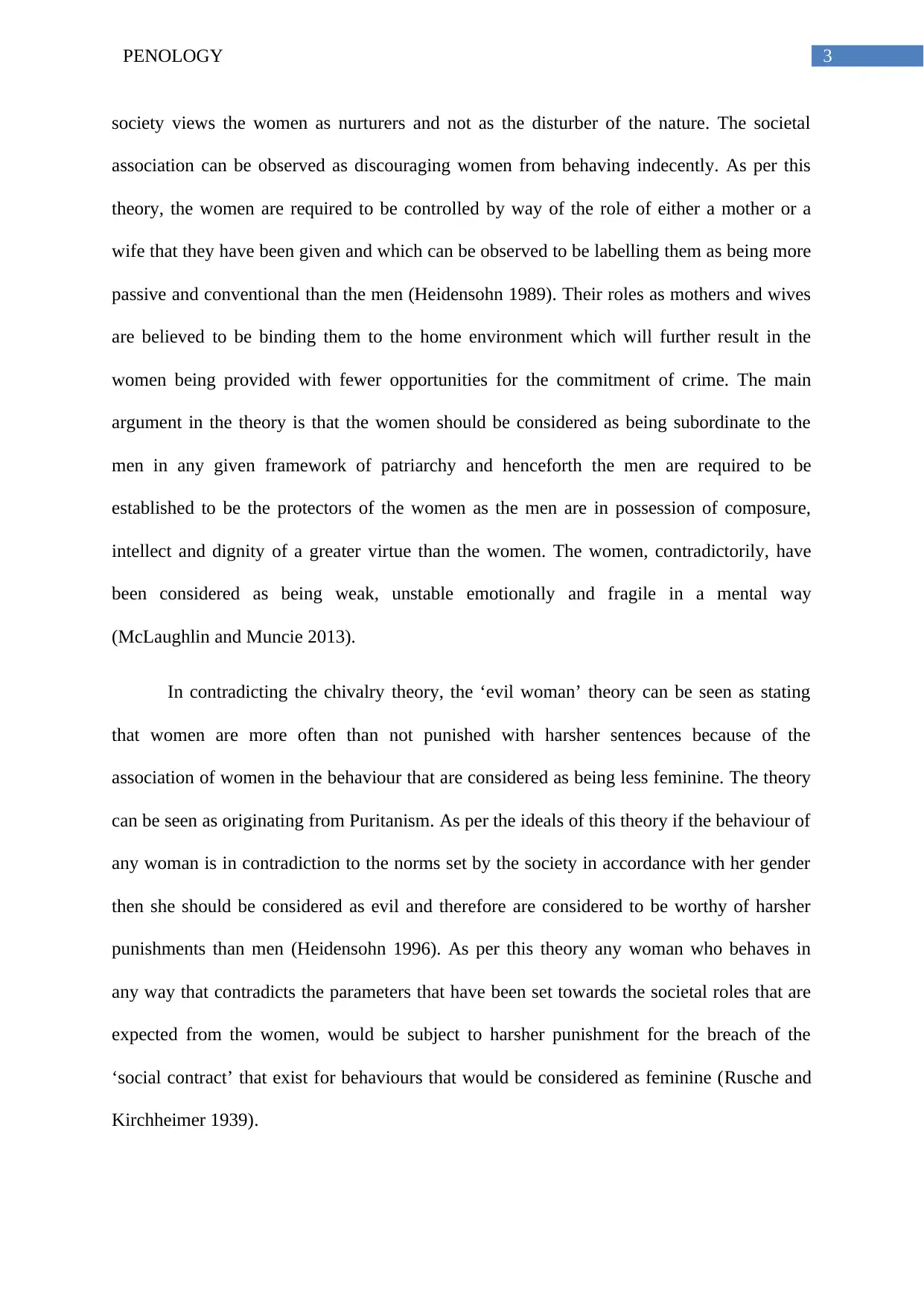
3PENOLOGY
society views the women as nurturers and not as the disturber of the nature. The societal
association can be observed as discouraging women from behaving indecently. As per this
theory, the women are required to be controlled by way of the role of either a mother or a
wife that they have been given and which can be observed to be labelling them as being more
passive and conventional than the men (Heidensohn 1989). Their roles as mothers and wives
are believed to be binding them to the home environment which will further result in the
women being provided with fewer opportunities for the commitment of crime. The main
argument in the theory is that the women should be considered as being subordinate to the
men in any given framework of patriarchy and henceforth the men are required to be
established to be the protectors of the women as the men are in possession of composure,
intellect and dignity of a greater virtue than the women. The women, contradictorily, have
been considered as being weak, unstable emotionally and fragile in a mental way
(McLaughlin and Muncie 2013).
In contradicting the chivalry theory, the ‘evil woman’ theory can be seen as stating
that women are more often than not punished with harsher sentences because of the
association of women in the behaviour that are considered as being less feminine. The theory
can be seen as originating from Puritanism. As per the ideals of this theory if the behaviour of
any woman is in contradiction to the norms set by the society in accordance with her gender
then she should be considered as evil and therefore are considered to be worthy of harsher
punishments than men (Heidensohn 1996). As per this theory any woman who behaves in
any way that contradicts the parameters that have been set towards the societal roles that are
expected from the women, would be subject to harsher punishment for the breach of the
‘social contract’ that exist for behaviours that would be considered as feminine (Rusche and
Kirchheimer 1939).
society views the women as nurturers and not as the disturber of the nature. The societal
association can be observed as discouraging women from behaving indecently. As per this
theory, the women are required to be controlled by way of the role of either a mother or a
wife that they have been given and which can be observed to be labelling them as being more
passive and conventional than the men (Heidensohn 1989). Their roles as mothers and wives
are believed to be binding them to the home environment which will further result in the
women being provided with fewer opportunities for the commitment of crime. The main
argument in the theory is that the women should be considered as being subordinate to the
men in any given framework of patriarchy and henceforth the men are required to be
established to be the protectors of the women as the men are in possession of composure,
intellect and dignity of a greater virtue than the women. The women, contradictorily, have
been considered as being weak, unstable emotionally and fragile in a mental way
(McLaughlin and Muncie 2013).
In contradicting the chivalry theory, the ‘evil woman’ theory can be seen as stating
that women are more often than not punished with harsher sentences because of the
association of women in the behaviour that are considered as being less feminine. The theory
can be seen as originating from Puritanism. As per the ideals of this theory if the behaviour of
any woman is in contradiction to the norms set by the society in accordance with her gender
then she should be considered as evil and therefore are considered to be worthy of harsher
punishments than men (Heidensohn 1996). As per this theory any woman who behaves in
any way that contradicts the parameters that have been set towards the societal roles that are
expected from the women, would be subject to harsher punishment for the breach of the
‘social contract’ that exist for behaviours that would be considered as feminine (Rusche and
Kirchheimer 1939).
Secure Best Marks with AI Grader
Need help grading? Try our AI Grader for instant feedback on your assignments.
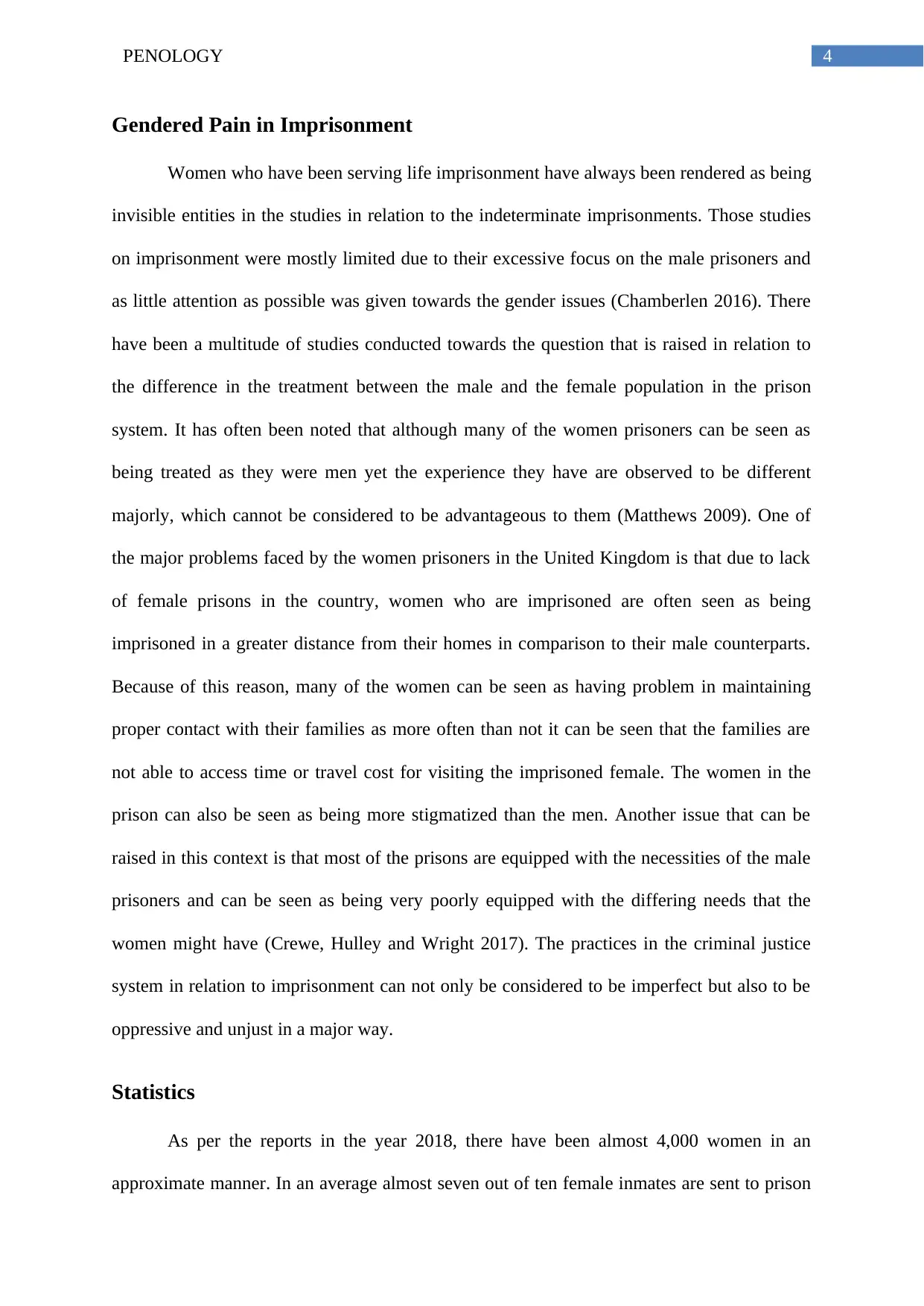
4PENOLOGY
Gendered Pain in Imprisonment
Women who have been serving life imprisonment have always been rendered as being
invisible entities in the studies in relation to the indeterminate imprisonments. Those studies
on imprisonment were mostly limited due to their excessive focus on the male prisoners and
as little attention as possible was given towards the gender issues (Chamberlen 2016). There
have been a multitude of studies conducted towards the question that is raised in relation to
the difference in the treatment between the male and the female population in the prison
system. It has often been noted that although many of the women prisoners can be seen as
being treated as they were men yet the experience they have are observed to be different
majorly, which cannot be considered to be advantageous to them (Matthews 2009). One of
the major problems faced by the women prisoners in the United Kingdom is that due to lack
of female prisons in the country, women who are imprisoned are often seen as being
imprisoned in a greater distance from their homes in comparison to their male counterparts.
Because of this reason, many of the women can be seen as having problem in maintaining
proper contact with their families as more often than not it can be seen that the families are
not able to access time or travel cost for visiting the imprisoned female. The women in the
prison can also be seen as being more stigmatized than the men. Another issue that can be
raised in this context is that most of the prisons are equipped with the necessities of the male
prisoners and can be seen as being very poorly equipped with the differing needs that the
women might have (Crewe, Hulley and Wright 2017). The practices in the criminal justice
system in relation to imprisonment can not only be considered to be imperfect but also to be
oppressive and unjust in a major way.
Statistics
As per the reports in the year 2018, there have been almost 4,000 women in an
approximate manner. In an average almost seven out of ten female inmates are sent to prison
Gendered Pain in Imprisonment
Women who have been serving life imprisonment have always been rendered as being
invisible entities in the studies in relation to the indeterminate imprisonments. Those studies
on imprisonment were mostly limited due to their excessive focus on the male prisoners and
as little attention as possible was given towards the gender issues (Chamberlen 2016). There
have been a multitude of studies conducted towards the question that is raised in relation to
the difference in the treatment between the male and the female population in the prison
system. It has often been noted that although many of the women prisoners can be seen as
being treated as they were men yet the experience they have are observed to be different
majorly, which cannot be considered to be advantageous to them (Matthews 2009). One of
the major problems faced by the women prisoners in the United Kingdom is that due to lack
of female prisons in the country, women who are imprisoned are often seen as being
imprisoned in a greater distance from their homes in comparison to their male counterparts.
Because of this reason, many of the women can be seen as having problem in maintaining
proper contact with their families as more often than not it can be seen that the families are
not able to access time or travel cost for visiting the imprisoned female. The women in the
prison can also be seen as being more stigmatized than the men. Another issue that can be
raised in this context is that most of the prisons are equipped with the necessities of the male
prisoners and can be seen as being very poorly equipped with the differing needs that the
women might have (Crewe, Hulley and Wright 2017). The practices in the criminal justice
system in relation to imprisonment can not only be considered to be imperfect but also to be
oppressive and unjust in a major way.
Statistics
As per the reports in the year 2018, there have been almost 4,000 women in an
approximate manner. In an average almost seven out of ten female inmates are sent to prison

5PENOLOGY
for serving a sentence of up to six months maximum. There have even been imprisonments of
the women for 30 days or less. Due to these short term imprisonments many women were
seen as losing their jobs, any kinds of contacts with their families and children and often
without any place to live. Comparing this to the male imprisonment rate it can be seen that
for every single female prisoner there are an approximate of 20 male prisoners. Three main
reasons can be seen as contributing to such difference in the numbers of male and female
populations in the prisons in United Kingdom. The first contributory factor that can be
considered is that the offenders sentenced to prison are mostly consisting of male offenders
than that of the female offenders (Di‐Lustro 2004). In an average, longer sentences of
imprisonment are given to men than to the female offenders. The third contributing factor can
be observed as the fact that compared to the female inmates, the male inmates serves greater
proportions of the sentences they receive.
Conclusion
In the current essay a detailed discussion has been conducted on the gender bias faced
during imprisonment. The essay discusses in detail about the gendered pains existing in the
prison system in the United Kingdom. The word ‘imprisonment’ can be labelled as the
actions of the quarantine of any person in a reformatory or prison as a punishment for any
kind of offense which are mostly carried out by way of the court. There have been numerous
arguments amidst the researchers about the presence of dissimilarity in the handling of the
men and women in the penal system. There have been debates among the scholars about
whether the women deserve lesser punishments than men because of the seriousness of their
offences. To discuss these dissimilarities, in the given context the essay provides the readers
with two contradicting theories. The first theory is the chivalry theory, whose main idea is
that the police, judges, magistrates or other prosecutors can be seen as treating women more
leniently because of their paternalistic or chivalrous behaviour towards the gender
for serving a sentence of up to six months maximum. There have even been imprisonments of
the women for 30 days or less. Due to these short term imprisonments many women were
seen as losing their jobs, any kinds of contacts with their families and children and often
without any place to live. Comparing this to the male imprisonment rate it can be seen that
for every single female prisoner there are an approximate of 20 male prisoners. Three main
reasons can be seen as contributing to such difference in the numbers of male and female
populations in the prisons in United Kingdom. The first contributory factor that can be
considered is that the offenders sentenced to prison are mostly consisting of male offenders
than that of the female offenders (Di‐Lustro 2004). In an average, longer sentences of
imprisonment are given to men than to the female offenders. The third contributing factor can
be observed as the fact that compared to the female inmates, the male inmates serves greater
proportions of the sentences they receive.
Conclusion
In the current essay a detailed discussion has been conducted on the gender bias faced
during imprisonment. The essay discusses in detail about the gendered pains existing in the
prison system in the United Kingdom. The word ‘imprisonment’ can be labelled as the
actions of the quarantine of any person in a reformatory or prison as a punishment for any
kind of offense which are mostly carried out by way of the court. There have been numerous
arguments amidst the researchers about the presence of dissimilarity in the handling of the
men and women in the penal system. There have been debates among the scholars about
whether the women deserve lesser punishments than men because of the seriousness of their
offences. To discuss these dissimilarities, in the given context the essay provides the readers
with two contradicting theories. The first theory is the chivalry theory, whose main idea is
that the police, judges, magistrates or other prosecutors can be seen as treating women more
leniently because of their paternalistic or chivalrous behaviour towards the gender
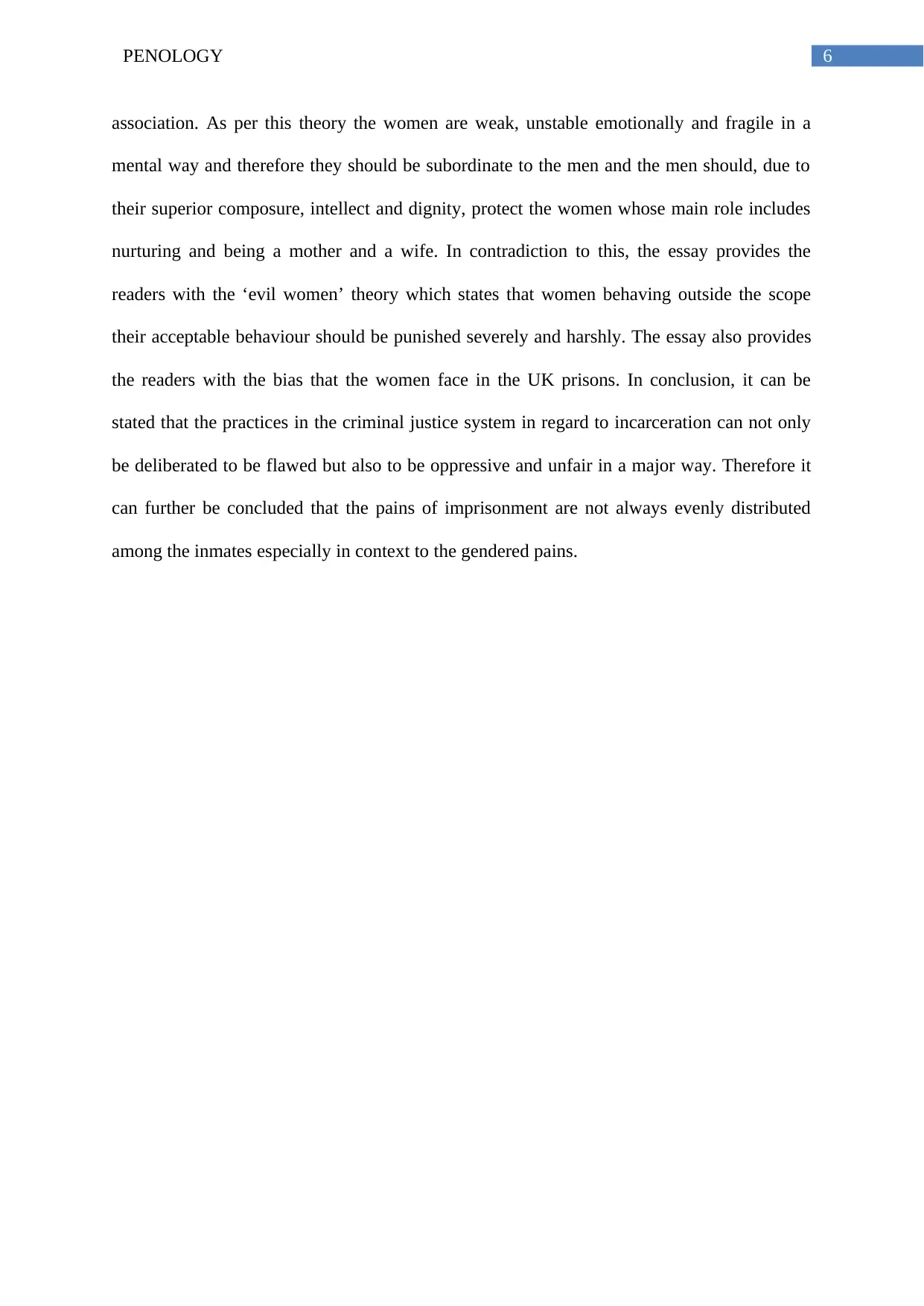
6PENOLOGY
association. As per this theory the women are weak, unstable emotionally and fragile in a
mental way and therefore they should be subordinate to the men and the men should, due to
their superior composure, intellect and dignity, protect the women whose main role includes
nurturing and being a mother and a wife. In contradiction to this, the essay provides the
readers with the ‘evil women’ theory which states that women behaving outside the scope
their acceptable behaviour should be punished severely and harshly. The essay also provides
the readers with the bias that the women face in the UK prisons. In conclusion, it can be
stated that the practices in the criminal justice system in regard to incarceration can not only
be deliberated to be flawed but also to be oppressive and unfair in a major way. Therefore it
can further be concluded that the pains of imprisonment are not always evenly distributed
among the inmates especially in context to the gendered pains.
association. As per this theory the women are weak, unstable emotionally and fragile in a
mental way and therefore they should be subordinate to the men and the men should, due to
their superior composure, intellect and dignity, protect the women whose main role includes
nurturing and being a mother and a wife. In contradiction to this, the essay provides the
readers with the ‘evil women’ theory which states that women behaving outside the scope
their acceptable behaviour should be punished severely and harshly. The essay also provides
the readers with the bias that the women face in the UK prisons. In conclusion, it can be
stated that the practices in the criminal justice system in regard to incarceration can not only
be deliberated to be flawed but also to be oppressive and unfair in a major way. Therefore it
can further be concluded that the pains of imprisonment are not always evenly distributed
among the inmates especially in context to the gendered pains.
Paraphrase This Document
Need a fresh take? Get an instant paraphrase of this document with our AI Paraphraser
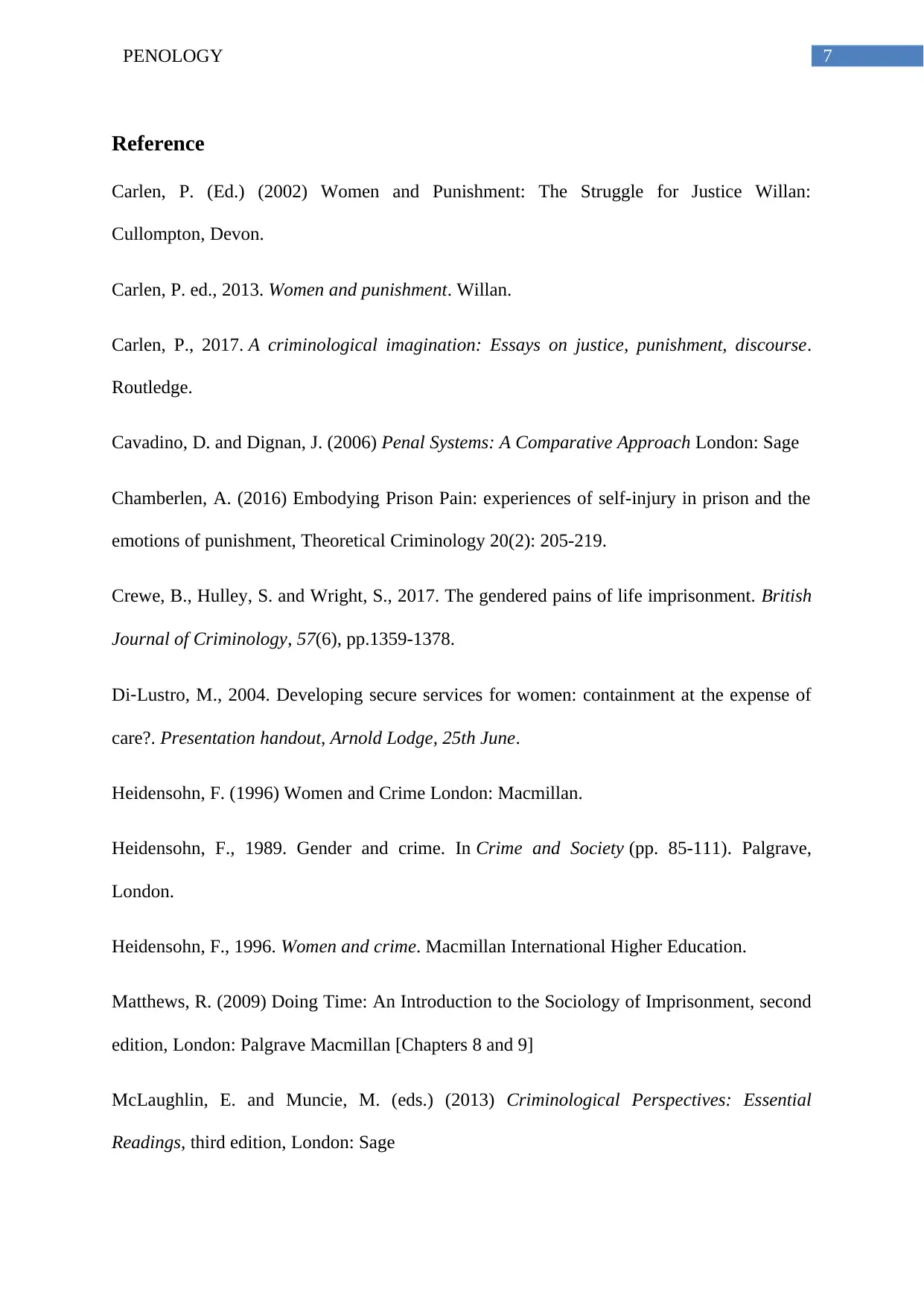
7PENOLOGY
Reference
Carlen, P. (Ed.) (2002) Women and Punishment: The Struggle for Justice Willan:
Cullompton, Devon.
Carlen, P. ed., 2013. Women and punishment. Willan.
Carlen, P., 2017. A criminological imagination: Essays on justice, punishment, discourse.
Routledge.
Cavadino, D. and Dignan, J. (2006) Penal Systems: A Comparative Approach London: Sage
Chamberlen, A. (2016) Embodying Prison Pain: experiences of self-injury in prison and the
emotions of punishment, Theoretical Criminology 20(2): 205-219.
Crewe, B., Hulley, S. and Wright, S., 2017. The gendered pains of life imprisonment. British
Journal of Criminology, 57(6), pp.1359-1378.
Di‐Lustro, M., 2004. Developing secure services for women: containment at the expense of
care?. Presentation handout, Arnold Lodge, 25th June.
Heidensohn, F. (1996) Women and Crime London: Macmillan.
Heidensohn, F., 1989. Gender and crime. In Crime and Society (pp. 85-111). Palgrave,
London.
Heidensohn, F., 1996. Women and crime. Macmillan International Higher Education.
Matthews, R. (2009) Doing Time: An Introduction to the Sociology of Imprisonment, second
edition, London: Palgrave Macmillan [Chapters 8 and 9]
McLaughlin, E. and Muncie, M. (eds.) (2013) Criminological Perspectives: Essential
Readings, third edition, London: Sage
Reference
Carlen, P. (Ed.) (2002) Women and Punishment: The Struggle for Justice Willan:
Cullompton, Devon.
Carlen, P. ed., 2013. Women and punishment. Willan.
Carlen, P., 2017. A criminological imagination: Essays on justice, punishment, discourse.
Routledge.
Cavadino, D. and Dignan, J. (2006) Penal Systems: A Comparative Approach London: Sage
Chamberlen, A. (2016) Embodying Prison Pain: experiences of self-injury in prison and the
emotions of punishment, Theoretical Criminology 20(2): 205-219.
Crewe, B., Hulley, S. and Wright, S., 2017. The gendered pains of life imprisonment. British
Journal of Criminology, 57(6), pp.1359-1378.
Di‐Lustro, M., 2004. Developing secure services for women: containment at the expense of
care?. Presentation handout, Arnold Lodge, 25th June.
Heidensohn, F. (1996) Women and Crime London: Macmillan.
Heidensohn, F., 1989. Gender and crime. In Crime and Society (pp. 85-111). Palgrave,
London.
Heidensohn, F., 1996. Women and crime. Macmillan International Higher Education.
Matthews, R. (2009) Doing Time: An Introduction to the Sociology of Imprisonment, second
edition, London: Palgrave Macmillan [Chapters 8 and 9]
McLaughlin, E. and Muncie, M. (eds.) (2013) Criminological Perspectives: Essential
Readings, third edition, London: Sage

8PENOLOGY
Rusche G. and Kirchheimer, O. (1939 [1969]) Punishment and Social Structure, New York:
Russell and Russell.
Rusche G. and Kirchheimer, O. (1939 [1969]) Punishment and Social Structure, New York:
Russell and Russell.
1 out of 9
Your All-in-One AI-Powered Toolkit for Academic Success.
+13062052269
info@desklib.com
Available 24*7 on WhatsApp / Email
![[object Object]](/_next/static/media/star-bottom.7253800d.svg)
Unlock your academic potential
© 2024 | Zucol Services PVT LTD | All rights reserved.